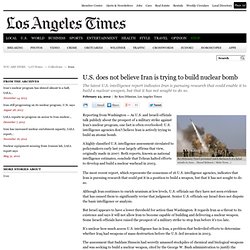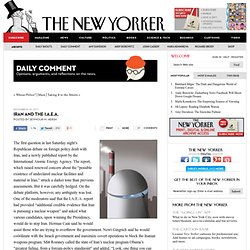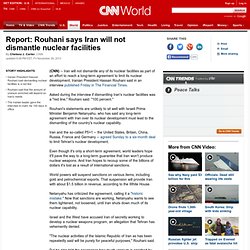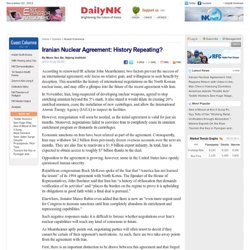

Already In Paper. The growing threat of Iran’s nuclear program. There’s just one problem with this narrative: It is divorced from reality. This week the International Atomic Energy Agency (IAEA) Is expected to report new details on Iran’s efforts to design a nuclear device. This is worrying enough, but the true measure of Iran’s progress toward nuclear weapons capability is the rate at which it is producing enriched uranium. By this measure, Iran is closer than ever to a nuclear weapon and its nuclear enrichment program has not been slowed but, rather, continues to accelerate. The last IAEA inspection report, issued in September, found almost 6,000 centrifuges spinning at Iran’s enrichment facility at Natanz — more than ever before — and these centrifuges were enriching faster than ever.
IAEA data indicate that in the first half of 2011, Iran was able to produce an average of almost 105 kilograms of low-enriched uranium per month. ThePoliticsOfUSEconSanctionsEconLit. Iran Nuclear Program: Status. The Value Of A Program: Study. U.N. inspectors visit Iranian site linked to nuclear program. Iran's President: Nuclear Deal Has Helped Economy. U.S. does not believe Iran is trying to build nuclear bomb. Revolutionary Guard personnel watch the launch of a Zelzal missile in June… (Raouf Mohseni / Mehr News…) Reporting from Washington — As U.S. and Israeli officials talk publicly about the prospect of a military strike against Iran's nuclear program, one fact is often overlooked: U.S. intelligence agencies don't believe Iran is actively trying to build an atomic bomb.

A highly classified U.S. intelligence assessment circulated to policymakers early last year largely affirms that view, originally made in 2007. Both reports, known as national intelligence estimates, conclude that Tehran halted efforts to develop and build a nuclear warhead in 2003. The most recent report, which represents the consensus of 16 U.S. intelligence agencies, indicates that Iran is pursuing research that could put it in a position to build a weapon, but that it has not sought to do so. I.A.E.A.
Iran and the I.A.E.A. The first question in last Saturday night’s Republican debate on foreign policy dealt with Iran, and a newly published report by the International Atomic Energy Agency.

The report, which raised renewed concern about the “possible existence of undeclared nuclear facilities and material in Iran,” struck a darker tone than previous assessments. But it was carefully hedged. On the debate platform, however, any ambiguity was lost. About the International Atomic Energy Agency (IAEA) Violence Regulations. Abstract.

Report: Iran will not dismantle nuclear facilities, Rouhani says. Iranian President Hassan Rouhani said dismantling nuclear facilities is a red lineRouhani said that the amount of uranium enriched will depend on Iran's needsThe Iranian leader gave the interview to mark his 100 days in office (CNN) -- Iran will not dismantle any of its nuclear facilities as part of an effort to reach a long-term agreement to limit its nuclear development, Iranian President Hassan Rouhani said in an interview published Friday in The Financial Times.

Asked during the interview if dismantling Iran's nuclear facilities was a "red line," Rouhani said: "100 percent. " Rouhani's statements are unlikely to sit well with Israeli Prime Minister Benjamin Netanyahu, who has said any long-term agreement with Iran over its nuclear development must lead to the dismantling of the country's nuclear capability. Iran and the so-called P5+1 -- the United States, Britain, China, Russia, France and Germany -- agreed Sunday to a six-month deal to limit Tehran's nuclear development.
Public Opinion. Iran needs nuclear energy, not weapons - Le Monde diplomatique - English edition. IF YOU read the media coverage of the presentation given to the United Nations General Assembly on 17 September by the Iranian president, Mahmoud Ahmadinejad, you could be forgiven for picturing him pounding his shoe on the podium, old Soviet-style, and yelling “We will bury you!”

Press reports on this speech in the United States described him as “threatening”, “aggressive” and “unyielding”. Dafna Linzer of the Washington Post went so far as to claim that he had said that Americans “brought the devastation of Hurricane Katrina upon themselves” (1). Why was his speech presented in this way? The usual pundits who dominate US newspaper column inches and television talk shows would reply that Iran is not to be trusted because it ran a clandestine nuclear enrichment programme, dramatically exposed in 2002. Iranian Nuclear Agreement: History Repeating? According to renowned IR scholar John Mearsheimer, two factors prevent the success of an international agreement; sole focus on relative gain, and willingness to seek benefit by deception.

This resembles the history of international negotiations on the North Korean nuclear issue, and may offer a glimpse into the future of the recent agreement with Iran. In November, Iran, long-suspected of developing nuclear weapons, agreed to stop enriching uranium beyond the 5% mark. It also stated it would dilute its existing 20% enriched uranium, cease the installation of new centrifuges, and allow the International Atomic Energy Agency (IAEA) to inspect its facilities. However, renegotiation will soon be needed, as the initial agreement is valid for just six months.